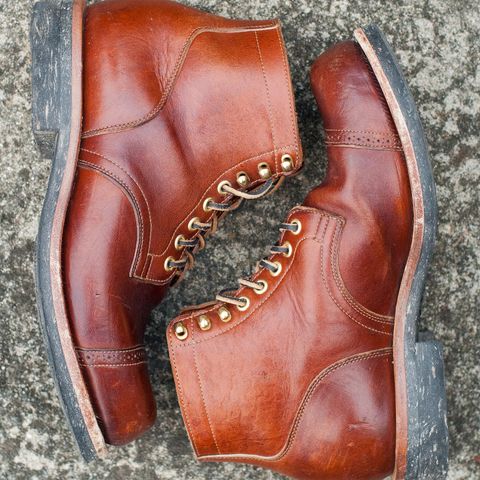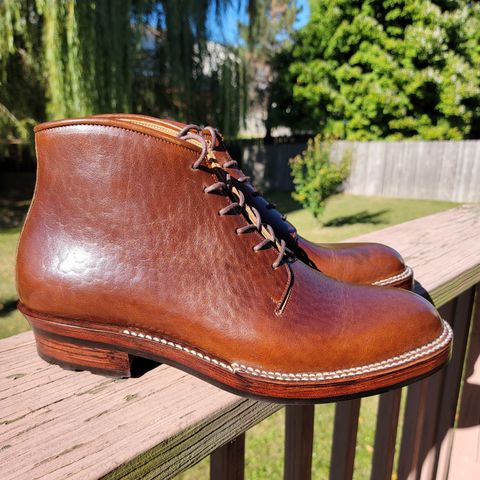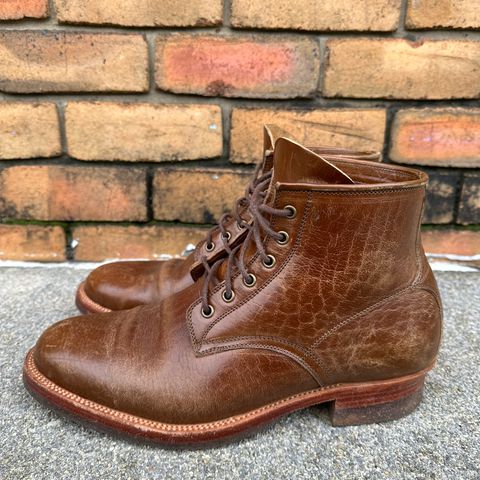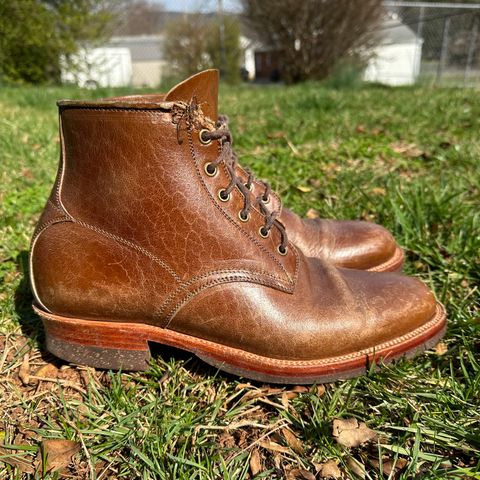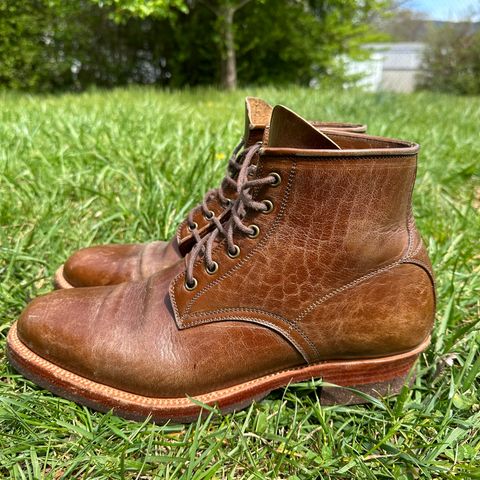About
Cognac is a rich brown color variation of Shinki Oiled Horsebutt leather produced by Shinki Hikaku tannery in Himeji, Japan. The leather features unique red undertones characteristic of Shinki's oiled horsebutt finish, distinguishing it from standard brown horse leathers. Production requires 10 months including two months submerged in vegetable tanning pits and three to four months of natural drying, resulting in leather with distinct grain and texture.
About
Cognac is a rich brown color variation of Shinki Oiled Horsebutt leather produced by Shinki Hikaku tannery in Himeji, Japan. The leather features unique red undertones characteristic of Shinki's oiled horsebutt finish, distinguishing it from standard brown horse leathers. Production requires 10 months including two months submerged in vegetable tanning pits and three to four months of natural drying, resulting in leather with distinct grain and texture.
Cognac oiled horsebutt retains the shell portion of the hide and is processed similarly to shell cordovan but classified as horsebutt due to smaller overall hide size. The leather is used primarily in heritage footwear, particularly service boots and chukka boots.
Production Process
Extended Timeline
The production of cognac oiled horsebutt spans 10 months from raw hide to finished leather. Initial processing includes two months with hides fully submerged in vegetable tanning pits using mimosa bark solution. After tanning, the leather undergoes three to four months of natural drying and curing, allowing the fibers to stabilize and compress.
Production timelines vary based on capacity constraints and material availability. During periods of limited production, estimated completion time may extend to six months from order placement.
Shell Portion Processing
Cognac oiled horsebutt contains the shell portion of the horse hide, the same dense fibrous area used in shell cordovan production. The leather undergoes processing methods similar to shell cordovan manufacturing, including extended vegetable tanning and natural drying periods. The classification as horsebutt rather than cordovan results from the smaller overall size of the processed hide section.
Leather Characteristics
Color and Appearance
The cognac color represents a rich brown tone with distinctive red undertones specific to Shinki's oiled horsebutt finish. The leather exhibits a glossy finish that maintains natural appearance rather than synthetic sheen. Color variations occur naturally across the surface, reflecting the inherent characteristics of the horse hide and vegetable tanning process.
Grain Structure
The grain displays subtle patterns including honeycomb-shaped stretch marks and vertical striations characteristic of horse butt leather. The grain remains tighter and more regular than bovine leather due to the dense collagen fiber structure in the horse's posterior region.
The leather surface is finished with a subtle shine that highlights material quality without creating excessive gloss. Natural grain variations provide visual texture distinct from uniform finished leathers.
Initial Feel and Flexibility
Cognac oiled horsebutt initially feels thick and almost impenetrable when first handled. The dense fibrous structure creates significant initial stiffness that requires breaking in through use. Over time, the leather relaxes and becomes more flexible while maintaining structural integrity.
Aging Behavior
Patina Development
The leather softens and becomes more flexible with regular wear. The aniline finish allows natural patina development as the surface is exposed to use, environmental conditions, and handling oils. Color deepening occurs gradually, with high-contact areas developing darker tones and increased luster.
The vegetable tanning process enables the leather to respond to wear patterns, creating unique aging characteristics that reflect individual use patterns.
Rolling Rather Than Creasing
Cognac oiled horsebutt tends to roll rather than form sharp creases when flexed repeatedly. This behavior results from the combination of dense fiber structure, high oil content, and vegetable tanning methods. Rolling creates softer, more gradual wear patterns compared to the sharp crease lines common in chrome-tanned leathers.
Character Development
The leather develops more pronounced character over time compared to many other leather types. Surface scuffs, scratches, and wear marks integrate into the overall patina rather than appearing as damage. The dense grain structure combined with aniline finish creates visible aging that heritage footwear enthusiasts value.
Technical Specifications
Material Properties
The leather is nonporous and extremely durable due to high connective tissue content in horse butt areas. This density provides unique resistance to creasing and structural deformation. The grain density contributes to added durability and abrasion resistance compared to cowhide alternatives.
The leather maintains the dense grain characteristics described for Shinki Oiled Horsebutt generally, including resistance to cracking, water resistance, and aging properties inherent to vegetable-tanned horsehide.
Production Source
Cognac oiled horsebutt is produced exclusively by Shinki Hikaku, the only tannery globally specializing exclusively in horse leather production. The tannery's specialized focus on horsehide materials has been maintained since founding in 1951.
Heritage Footwear Applications
Cognac oiled horsebutt appears in service boots constructed with stitchdown methods, featuring brogue toe caps, tonal eyelets, and speedhooks. The leather is commonly paired with Ridgeway soles for outdoor-capable heritage boot constructions.
The color is available in chukka boot styles with 360-degree Goodyear split reverse welt construction. Boot manufacturers typically offer cognac oiled horsebutt in limited production runs due to material scarcity and extended production timelines required for this specific leather.
References
"Service Boot Shinki Horsebutt". Viberg Journal. Retrieved October 11, 2025.
"Shinki Hikaku Tannery". Viberg Journal. Retrieved October 11, 2025.
"The 2040 Service Boot in Shinki Black Horsebutt". Standard & Strange. Retrieved October 11, 2025.
"Shinki Tannery—The Best Leather for Horsehide Jackets". Himel Bros. Retrieved October 11, 2025.

